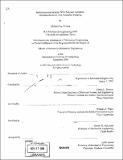| dc.contributor.advisor | Edwin L. Thomas and William A. Peters. | en_US |
| dc.contributor.author | Cromie, Melinda Joy | en_US |
| dc.contributor.other | Massachusetts Institute of Technology. Dept. of Mechanical Engineering. | en_US |
| dc.date.accessioned | 2006-08-25T18:55:19Z | |
| dc.date.available | 2006-08-25T18:55:19Z | |
| dc.date.copyright | 2005 | en_US |
| dc.date.issued | 2005 | en_US |
| dc.identifier.uri | http://hdl.handle.net/1721.1/33902 | |
| dc.description | Thesis (S.M.)--Massachusetts Institute of Technology, Dept. of Mechanical Engineering, 2005. | en_US |
| dc.description | Includes bibliographical references (leaves 105-109). | en_US |
| dc.description.abstract | The mission of the ISN is to explore the long-range vision of the role of nanotechnology in the future of soldier protection. Unprecedented survivability will arise from the cohesive and comprehensive coordination of the functions and interactions of each technology. The present work approaches these objectives with basic research to support the development of two multifunctional soldier survivability systems, pumping microfibers and mechanochromic pixels. Progress was made along the two major paths of investigation towards the realization of a pumping microfiber. Polypyrrole was chemically deposited onto copolyetherester. Tubular polypyrrole actuators at the millimeter scale were electrochemically fabricated and actuated. Mechanochromic polymers can be combined with actuating polymers to create a color changing pixel. Reflectance spectrum changes with strain in mechanochromic materials were characterized. Several pixel designs were analyzed and tested in which the polymer actuator polypyrrole induces deformation of the mechanochromic block copolymer. Integrative studies inform the overall systems architecture of the far future battlesuit. Scoping calculations to investigate battlesuit functionality requirements were performed. | en_US |
| dc.description.abstract | (cont.) The multiscale, multifunctional design solutions employed in the human body and the US Army and were studied, and the Dynamic Systems Integration Map was developed to apply the lessons learned to coordinate and leverage the many emerging survivability technologies. | en_US |
| dc.description.statementofresponsibility | by Melinda Joy Cromie. | en_US |
| dc.format.extent | 109 leaves | en_US |
| dc.format.extent | 8114797 bytes | |
| dc.format.extent | 8119328 bytes | |
| dc.format.mimetype | application/pdf | |
| dc.format.mimetype | application/pdf | |
| dc.language.iso | eng | en_US |
| dc.publisher | Massachusetts Institute of Technology | en_US |
| dc.rights | M.I.T. theses are protected by copyright. They may be viewed from this source for any purpose, but reproduction or distribution in any format is prohibited without written permission. See provided URL for inquiries about permission. | en_US |
| dc.rights.uri | http://dspace.mit.edu/handle/1721.1/7582 | |
| dc.subject | Mechanical Engineering. | en_US |
| dc.title | Multifunctional systems with polymer actuators : mechanochromism and peristalic pumping | en_US |
| dc.type | Thesis | en_US |
| dc.description.degree | S.M. | en_US |
| dc.contributor.department | Massachusetts Institute of Technology. Department of Mechanical Engineering | |
| dc.identifier.oclc | 66528589 | en_US |
